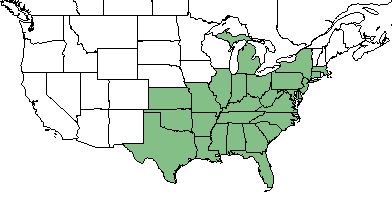Difference between revisions of "Paspalum laeve"
(→Ecology) |
(→Ecology) |
||
| Line 35: | Line 35: | ||
The grass has a intermediate level of shade and drought tolerance. <ref name= "USDA"> [https://plants.usda.gov/core/profile?symbol=CEAM USDA Plant Database]</ref> | The grass has a intermediate level of shade and drought tolerance. <ref name= "USDA"> [https://plants.usda.gov/core/profile?symbol=CEAM USDA Plant Database]</ref> | ||
<!--Natural communities, human disturbed habitats, topography, hydrology, soils, light, fire regime requirements for removal of competition, etc.--> | <!--Natural communities, human disturbed habitats, topography, hydrology, soils, light, fire regime requirements for removal of competition, etc.--> | ||
| − | + | ===Phenology=== | |
''P. laeve'' flowers infrequently during June and September.<ref name= "Pan Flora"> [http://www.gilnelson.com/PanFlora/ Pan Flora]</ref> | ''P. laeve'' flowers infrequently during June and September.<ref name= "Pan Flora"> [http://www.gilnelson.com/PanFlora/ Pan Flora]</ref> | ||
<!--Timing off flowering, fruiting, seed dispersal, and environmental triggers. Cite PanFlora website if appropriate: http://www.gilnelson.com/PanFlora/ --> | <!--Timing off flowering, fruiting, seed dispersal, and environmental triggers. Cite PanFlora website if appropriate: http://www.gilnelson.com/PanFlora/ --> | ||
Revision as of 17:27, 24 May 2018
| Paspalum laeve | |
|---|---|

| |
| Photo by Keith Bradley hosted at Atlas of Florida Plants | |
| Scientific classification | |
| Kingdom: | Plantae |
| Division: | Magnoliophyta - Flowering plants |
| Class: | Liliopsida - Moncots |
| Order: | Poales |
| Family: | Poaceae |
| Genus: | Paspalum |
| Species: | P. laeve |
| Binomial name | |
| Paspalum laeve Michx. | |

| |
| Natural range of Paspalum laeve from USDA NRCS Plants Database. | |
Contents
Taxonomic Notes
Synonym: P. longipilum(Nash)
Variety: Paspalum laeve var. circulare (Nash) Stone
Description
P. laeve is a perennial graminoid of the Poaceae family that is native to North America. [1]
Distribution
P. laeve is found throughout the southeastern United States, reaching as far north as New York and Michigan, and as far west as Texas and Kansas. [1]
Ecology
Habitat
This perennial grass is commonly found on forest edges, and disturbed areas. [2]
The grass has a intermediate level of shade and drought tolerance. [1]
Phenology
P. laeve flowers infrequently during June and September.[3]